Abstract
The search for new natural, sustainable, economical and biodegradable reinforcements for composite materials has increased in recent years, highlighting the importance of fibers from the natural environment. This work evaluates the use of tururi fibrous fabric as a reinforcement in a polymer matrix, using Fourier transform infrared spectroscopy, X-ray diffraction, thermogravimetry and scanning electron microscopy. The mechanical and fractographic performance of composites reinforced with 2.5, 5.0 and 7.5% mass fraction of tururi in a polyester matrix is also investigated. The FTIR and XRD results identified groups characteristic of natural fibers and the presence of elemental constituents such as cellulose, hemicellulose and lignin. Thermogravimetry indicated good thermal stability near 246 °C. The morphology of the fibrous fabric is irregular and formed by tangles of threads. The mechanical behavior of the composites in bending revealed a variation in stress with the increase in the percentage of fabric in the matrix, explained by defects and failures due to low interfacial adhesion between the phases. Impact tests indicated that increasing the percentage of fabric in the matrix improves impact energy absorption, reflecting better adhesion and load distribution. Thus, the development of this natural composite is promising for applications in green and sustainable products.
1. Introduction
Sustainable development is a determining environmental issue in the design of new materials. In this context, composite materials have been attracting attention on a global scale, as they have interesting environmental and mechanical requirements for various applications [1,2,3]. These materials are used on a large industrial scale due to their high resistance to stress and low specific mass. Industries such as aerospace, automotive, shipbuilding, packaging, and medicine and biomedicine use composite materials as a basis for the development of high- and low-intensity activities [4,5,6,7,8].
Increasing concerns about climate change and excessive carbon dioxide emissions have driven the development of sustainable, biodegradable and less environmentally aggressive materials [9]. As a result, the use of natural inputs from environmental reutilization, most notably natural fibers as reinforcements in polymer matrix composites, has leveraged the technical–scientific field in the manufacture of new products. The use of natural reinforcements has a number of advantages, such as low density, low purchase price, biodegradability and non-toxicity, as well as great environmental availability [7,10,11].
Lignocellulosic fibers from large and small plants have cellulose, hemicellulose, pectin and lignin as elementary components, in varying proportions [12,13,14,15]. For this reason, the use of environmentally recyclable natural inputs, particularly natural fibers as reinforcements in polymer matrix composites, is driving innovation in the technical–scientific field, leading to the manufacture of new products. The use of natural reinforcements has a number of advantages, such as low density, low purchase value, biodegradability and non-toxicity, as well as great environmental availability [7,10,11,16,17,18].
The main properties of composite materials reinforced with natural fibers are high mechanical strength due to the presence of cellulosic material, low density, high rigidity, low abrasiveness, wear resistance and a lower specific weight [19,20,21,22,23,24]. In addition, the arrangement and characteristics of the fibers, whether they are continuous or in the form of yarns or mats, make the composite material even more attractive for various industrial applications, with a view to replacing petroleum-derived fibers. Studies have been carried out to understand how the insertion of fabrics made from natural and synthetic fibers affects the properties of polymer matrix composite materials [25,26].
Oliveira et al. (2020) [27] developed polybenzozaxine composites reinforced with tururi fabric and observed a bending elastic modulus of 2 GPa and elevated glass transition temperatures. Ng et al. (2022) [28] observed that the manufacture of fabrics using natural and synthetic pineapple and glass fibers, respectively, results in lightweight composites with good mechanical properties that are environmentally interesting for application in the transport sector. In another study, Ng et al. (2024) [29] observed that the constitution of a hybrid fabric of ramie and pineapple fibers oriented in different directions shows high resistance to impact, traction and bending, due to the easy distribution of the load along the layers. In addition, they explain that hybrid fabrics have great potential for use, due to the environmentally friendly aspect of the material. Monteiro et al. [30] characterized tururi fabric and found tensile strength values of 17.6 MPa, as well as functional groups corresponding to cellulose, hemicellulose and lignin. Porras et al. [31] also characterized tururi fabric for use as a reinforcement in composites and concluded that cellulose and lignin were the main constituents in higher amounts, and that the fabric surface was coated with waxes and fats, suggesting that a chemical treatment could promote the removal of these compounds and improve interfacial adhesion. Midani et al. [32] studied the effects of the structural parameters of tururi fabric on the impact properties of multilayer composites and observed that increasing the number of layers led to a reduction in impact absorption capacity, with failure occurring due to matrix delamination, indicating lower fabric wettability by the resin.
On the scene of discoveries of new reinforcements for composite materials is tururi fabric. This fabric is extracted from the Ubuçu palm (Manicaria saccifera), a tree common in Latin America and used by native communities for a variety of applications. Straw and candles are made from the leaves, while drinks and other medicinal remedies are produced from the fruit, as well as hats and fishing accessories. The bracts form sacs that give rise to a fibrous fabric, which can be obtained in the form of an involucre [30,31]. The use of a natural fabric covers three dimensions (economic, social and sustainable development), requirements that make it interesting for use as a reinforcement. Although it is a fabric that has already been used as a reinforcement in composite materials [26,27,30,32] for the first time, the mechanical and dynamic mechanical behavior, as well as the Charpy impact energy, of polyester matrix composites reinforced with tururi fabric at mass percentages of 2.5, 5.0 and 7.5% are investigated, making it a relevant study in the field of composites reinforced with natural fiber fabrics, thus making it more attractive for the manufacture of new materials. Additionally, although the literature [26,27,30,32] provides relevant information on the fabric and composites, none of them investigated the reinforcement potential of tururi fabric in a polyester matrix, making the present study important for elucidating issues such as mechanical behavior as a function of temperature, the influence of fabric addition on the glass transition temperature of the polymer, and the absorbed impact energy. In this context, the objective of this work is to evaluate, through a series of analyses and tests, the potential use of a tururi fibrous fabric reinforcement for polyester polymer matrix composites.
2. Materials and Methods
The tururi fibrous fabric was obtained commercially at the Ver-o-Peso market in Belém-PA, Brazil. The material was naturally obtained, without any previous chemical treatment. Figure 1 shows the ubuçu plant, the region where it was extracted and the fabric used.

Figure 1.
Ubuçu plant (a) [33], fabric extraction site [33] (b) and tururi fabric (c).
The matrix used was a medium-viscosity isophthalic polyester resin and methyl ethyl ketone peroxide (MEK) hardening agent, supplied by Center Glass (Belém, PA, Brazil). The polyester resin was mixed with the hardening agent in a proportion of 1.5% by weight.
Table 1 shows the chemical composition of tururi fabric according to all TAPPI T203 and T222.

Table 1.
Chemical analysis of tururi fabric.
2.1. Composites Preparation
The composites were produced manually using the hand lay-up process, which consists of the dimensions of the ASTM D 790 [34] and ASTM D6110 [35] standards. The specimens were made using mass proportions of 2.5, 5.0 and 7.5% by weight of tururi fabric reinforcement, manually cut according to the specifications of each standard. The composites were produced manually using a silicone mold, where the tururi fabric was aligned longitudinally. After curing for 24 h, the specimens were demolded and sanded with 80 and 600 mesh grain sizes, followed by flexural and impact tests.
2.2. X-Ray Diffraction (XRD)
The qualitative crystalline phases were obtained by XRD in a Proto Manufacturing, XRD Powder Diffraction System: 30 kV and 2 mA generator, Cu-Kα1 radiation, angular step of 0.0149°, 0.5 s time interval, 47 min scan and 2θ ranging from 5° to 60°. The crystallinity index was calculated using Equation (1) [36].
where the following are defined:
CI: crystallinity index; : maximum intensity associated with the crystalline plane of cellulose; : maximum intensity associated with the amorphous plane of cellulose.
Microfibril Angle (MFA)
The microfibrillar angle for tururi fabric was calculated using the Origin® software program, based on the method described by Cave [37], considering the cellulose peak (0 0 2). Based on the relationship between the Gauss curve and the first- and second-order curves, the “T” parameter is obtained and then applied to the following expression:
2.3. Thermogravimetric Analysis (TGA)
Thermogravimetric analysis was carried out in a NETZSCH (Berlin, Germany) model STA 449 F3 analyzer. The atmosphere used was nitrogen a flow rate of 50 mL/min, a heating rate of 10 °C/min, and a temperature range from 25 to 500 °C.
2.4. Fourier Transform Infrared Spectroscopy (FTIR)
The FTIR of the fabric was carried out using BRUKER equipment, model VERTEX 70V, using an infrared range of 4000–400 cm−1. The FTIR analysis for the composites was carried out on equipment produced by Thermo Scientific, model NICOLET 6700 using an infrared range of 4000–500 cm−1.
2.5. SEM Analysis
A morphological analysis of the tururi fabric and fractographic analysis of the composites were carried out using a model Mira3 FEG 250 TESCAN microscope (Brno, Czech republic) operating with secondary electrons at 5 KV and a working distance ranging from 25 to 10 mm.
2.6. Mechanical Properties Tururi Fabric
The tururi fabric samples were tested according to the ASTM D5035, using an iM50 Universal Electromechanical Machine (Mogi das Cruzes, SP, Brazil), using a 5 kN load cell at a tensile and bending speed of 10 mm/min. Twenty specimens cut by hand according to the dimensions of the standard used were tested.
2.7. DMA
The DMA test was carried out using the single-cantilever configuration. The test was carried out on a TA instrument Q800 V21.3, at a temperature rate of 20 to 200 °C with heating of 3 °C per minute and frequency 1 Hz, in a nitrogen atmosphere. The dimensions used were 12 × 46 × 3 mm.
2.8. Flexure Test
The flexure test was carried out on EMIC electromechanical universal equipment model (DL500), with a 5 KN load cell and a loading rate of 2 mm/min. The test was carried out in compliance with ASTM D790–17 [34].
2.9. Charpy Impact Test
The Charpy impact test was carried out on instrumented pendulum equipment from PANTEC, model XC-50, 1× 200 V × 60 Hz with a pendulum of 0.7 J. The specimens were produced with prismatic dimensions and a 2.54 mm deep notch. The test was carried out in accordance with ASTM D6110 [35].
2.10. Statistical Analysis
A statistical validation of the data was carried out using the analysis of variance (ANOVA) tool, with a 95% confidence interval (p < 0.05). Mean values were compared using the Tukey test.
3. Results
3.1. Characterization of Tururi Fabric
3.1.1. XRD Analysis
Figure 2 shows the x-ray diffractogram obtained for tururi fabric.
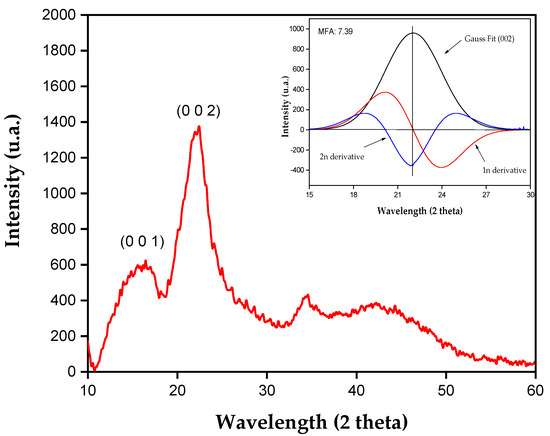
Figure 2.
XRD pattern of the tururi fabric.
The XRD analysis shows halos at angles of 16.23° and 22.32°, characteristic of the 1 0 1 and 0 0 2 planes, respectively. The peaks at 16.23° and 22.32° indicate the presence of amorphous constituents such as hemicellulose, lignin and pectins, in addition to crystalline cellulose. These results are similar to those found for natural fibers such as guaruman [38,39], ubim [40] and periquiteira [41].
The crystallinity index of the tururi fabric was 46.67%.
Table 2 compares the crystallinity index results of different natural fibers.

Table 2.
Comparative results of crystallinity indices (CIs) of different natural fibers and tururi fabric.
Although the tururi fabric has a lower crystallinity index, it still outperforms fibers such as pineapple, Citrullus lanatus and Cereus hildmannianus, which have exhibited even lower indices [48,50,52].
Natural fibers have compatible microfibril structural arrangements, which determine the microfibril angle (MFA). Fibers with a low MFA, above 0°, tend to be stronger and stiffer, while fibers with a high MFA, above 90°, are more flexible and susceptible to fracture [45].
The microfibrillar angle of the tururi fabric, calculated from the peak intensity of 22.32° [48], was 7.39°. This value is close to the value obtained for other lignocellulosic fibers, such coconut palm fiber, Eurcraea foetida, Ubim and periquiteira [40,41,53,54]. According to JUNIO et al. [41], low MFA values indicate good mechanical properties, making these fibers suitable for reinforcements.
The results show that tururi fabric has structural characteristics typical of natural fibers. The presence of these constituents reinforces the potential use of the fabric in polymer matrix composite materials.
3.1.2. TGA
The thermogravimetric curve (TG) and the thermogravimetric derivative (DTG) for tururi fibrous fabric are shown in Figure 3.
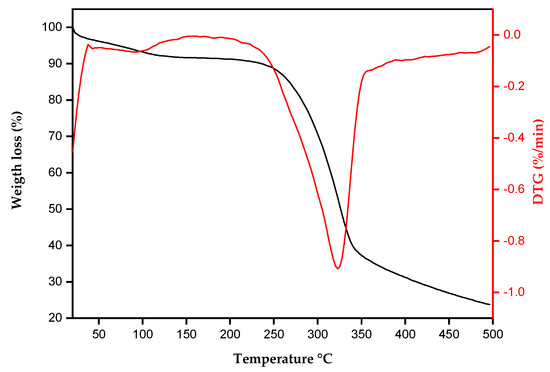
Figure 3.
TG and DTG for tururi fabric.
The thermogravimetric (TG) curve shows three distinct mass loss events. The first occurs at around 102 °C, indicating the loss of residual moisture, as reported by Dalmis et al. [55] and Khan et al. [56]. The second event occurs at approximately 247 °C, associated with the initial thermal degradation of hemicellulose and pectins present in lignocellulosic fibers, in addition to the release of all structural water [57,58]. The third and final thermal degradation event occurs at around 334 °C, corresponding to the beginning of the degradation of cellulose and other organic components [59]. This process involves the depolymerization, decarboxylation and decomposition of the glucose units present in the structure of lignocellulosic fibers [60,61]. The thermogram shows that tururi fibrous fabric maintains good thermal stability up to approximately 246 °C. Above this temperature, the thermal degradation of the fabric begins. The results suggest that tururi fabric has adequate thermal stability, which makes it promising for applications in polymeric matrices.
3.1.3. FTIR Analysis
Figure 4 shows the spectrum for tururi fibrous fabric.
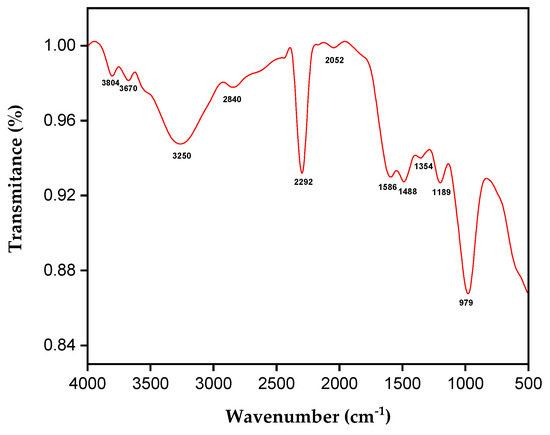
Figure 4.
FTIR of tururi fabric.
FTIR is an important characterization technique for identifying the functional groups or absorption bands of constituents. Between 3600 and 3100 cm−1, two vibrational bands are observed that can be attributed to the stretching of the hydroxyl group (OH-) [62,63]. At 2840 cm−1, the vibrational stretching of the CH and CH2 bonds, constituents of cellulose and hemicellulose, is observed [64]. At 2355 cm−1, there is stretching of the C=C bonds and the presence of waxes [41,65]. The absorption band at 2052 cm−1 corresponds to the stretching of the C≡N and C≡C bonds [66]. At 1586 cm−1, the stretching of the C-C bonds of the aromatic lignin ring is observed [31]. The peak observed at 1488 cm−1 corresponds to the C-H bond bending frequency of cellulose [62]. At 1354 cm−1, there is stretching of the acetyl group of lignin [31]. The band at 1189 cm−1 corresponds to the stretching of the C-O-C group of the lignin and hemicellulose constituents [51]. At 979 cm−1, it is associated with the crystalline cellulose constituent [60]. Tururi fabric shows absorption bands characteristic of natural fibers.
3.1.4. SEM Analysis of Tururi Fabric
The morphology of tururi fabric was analyzed using scanning electron microscopy, as shown in Figure 5.
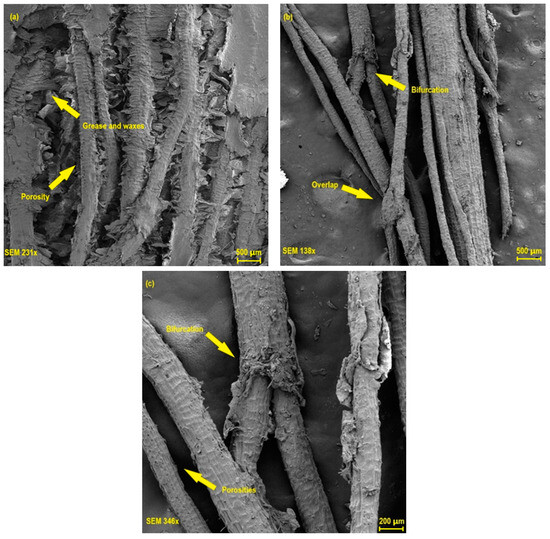
Figure 5.
Scanning electron microscopy obtained for the tururi fabric. (a) tururi fabric yarns oriented on different surfaces, 231×, (b) tuturi fabric with magnification of 138× and (c) tuturi fabric with magnification of 348×.
Figure 5a shows that the tururi fibrous fabric is structured by yarns oriented on different surfaces, as well as having heterogeneous and irregular surfaces formed by roughness, pores and organic matter such as grease and wax [64,67]. Although the presence of pores and imperfections limits the mechanical performance of the fabric, these aspects can contribute positively to better anchoring and interfacial adhesion between the fabric and the polymer matrix, favoring the formation of more resistant and rigid green materials [27,49]. Oliveira et al. [68] and Porras et al. [31] also observed similar behavior when investigating the properties of tururi fabric. In Figure 5b,c, areas can be observed composed of interlacing, bifurcations and overlapping of threads that present characteristics of the fabric. The bifurcations have a fibrous structure and help with load distribution, the breaking mode and the interaction between the matrix and the fabric. Karthik et al. [69] and Gao et al. [70] explained that the structural organization of yarns or fibers directly determines the properties of composite materials.
Tururi fabric has morphological characteristics similar to those of other natural fibers already investigated in the literature, such as Vachellia farnesiana, Citrullus lanatus and Cortaderia selloana [52,56,71].
3.1.5. Mechanical Properties Tururi Fabric
Figure 6 illustrates the tensile strength of the tururi fabric as a function of strain.

Figure 6.
Tension versus strain curve of natural tururi fabric.
The tururi fabric had a maximum tensile strength peak of 60 MPa and an average Young’s modulus of 1.1 GPa. After reaching the point of maximum tension, the filaments of the fabric tend to fail in different directions, due to the redistribution of tensions and the breaking of the fibers. This characteristic is associated with the structural design of tururi fabric, which comprises natural fibers arranged in multiple directions or interlaced, as described by Porras et al. [31].
The results obtained for tururi fabric are superior to those of other natural fibers, such as Corypha taliera [66] and coconut [72]. However, studies carried out by Akter et al. (2025) [73] indicated that fabrics made from jute fibers have superior mechanical performance compared to tururi fabric. However, the properties of tururi fabric, combined with its environmental characteristics, reinforce its potential as a reinforcement material in sustainable composite applications.
3.2. Characterization of Composite Materials
3.2.1. FTIR Composite Analysis
Figure 7 shows the spectrum obtained for the composites reinforced with tururi fabric with different percentages of incorporation.
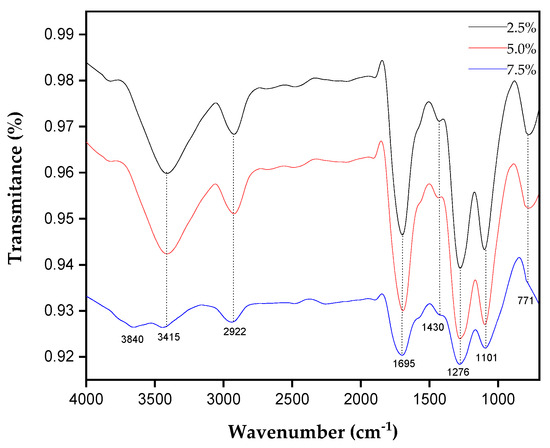
Figure 7.
FTIR of composite materials reinforced with tururi fabric.
The band observed at 3415 cm−1 is characteristic of the stretching of the hydroxyl cluster [2]. The band observed at 2922 cm−1 corresponds to the asymmetric stretching of the CH bond. At 1695 cm−1, an expressive peak is presented which is related to the grouping between the C=C bond of the carbonyl [2]. The band observed at 1430 cm−1 corresponds to the stretching of the bonds in the aromatic ring of lignin [74]. At 1276 cm−1, it refers to the stretching of the CO bonds of the acetyl ketone group [55]. At 771 cm−1, it corresponds to the stretching of the C=H bond [2,75]. As the percentage of the fabric increases, the transmission bands decrease, confirming that the percentage variation had an influence on the composition of the material.
3.2.2. DMA of Composites
Figure 8 shows the dynamic storage modulus (E′), tan delta (δ) and loss storage modulus (E″) for the composites with 2.5, 5.0 and 7.5% mass fraction of fabric in relation to temperature.
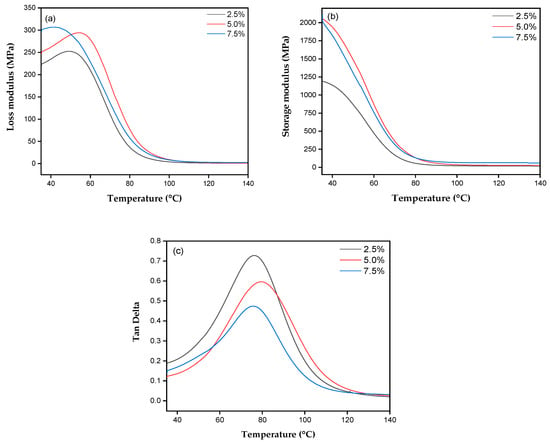
Figure 8.
DMA curves of the composites of (a) loss modulus, (b) storage modulus and (c) tan delta.
The DMA curves show that the composites reinforced with 2.5% fabric had an E′ equal to 1195 MPa, while the composites reinforced with 5.0 and 7.5% exhibit an E′ of 2077 and 2107 MPa, respectively. The increase in the percentage of fabric, as well as the increase in temperature, influenced the decrease in the storage modulus of the composites. These results suggest that increasing the percentage of reinforcement can provide greater rigidity and thermal and mechanical stability, as well as influencing movement in the vitreous transition region. In addition, the formation of bonds prevents the movement of the polymer chains, increasing the storage modulus. In this case, high stress is required to break the bonds between the interfaces and cause the material to rupture [76].
The loss of storage behavior shows that the 2.5% curve has a lower peak and a lower vitreous transition temperature. However, the composites with 5 and 7.5% reinforcement showed higher E″ peaks and a higher vitreous transition temperature compared to the composites with 2.5%. This indicates that the increase in reinforcement restricts the movement of the polymer chains due to the density of the cross-links, suggesting that there is an interaction between the fabric and the matrix [15].
The tan delta, which evaluates the material’s viscoelastic energy dissipation, showed that higher reinforcement percentages of 5 and 7.5% tururi fabric dissipated less energy during strain, resulting in a rigid and mechanically efficient material. This behavior suggests that increasing the reinforcement content contributes positively to the structure of the material, reducing the exclusive dependence on the polymer matrix for mechanical performance.
3.2.3. Flexure Test
The flexural strength of the polyester matrix composites reinforced with tururi fibrous fabric is shown in Figure 9.
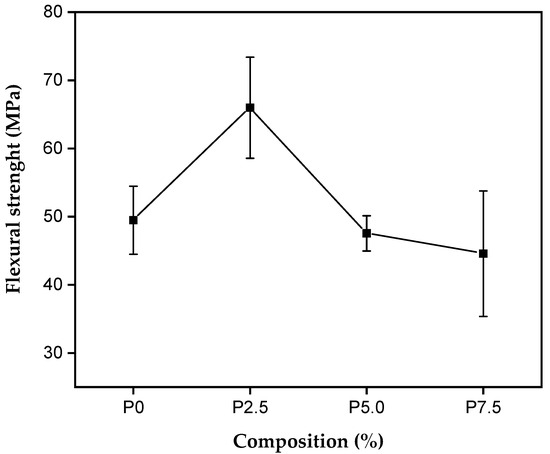
Figure 9.
Flexural strength of composites reinforced with tururi fabrics.
Table 3 shows the flexural strength, modulus of elasticity and strain results for the composites reinforced with natural tururi fabric.

Table 3.
Flexural strength results for tururi/polyester composites.
The composition with 2.5% reinforcement showed the best flexural strength results, with an average of 65 MPa. The compositions with 5.0% and 7.5% reinforcement showed lower results than the polyester matrix and the composition with 2.5%. The relative decrease in flexural strength may be associated with the presence of organic compounds in the fibrous fabric, which make it difficult to anchor the reinforcement to the matrix [77,78]. In addition, it is suggested that the presence of pores, microstructural damage and bubbles act as stress concentrators, reducing the mechanical strength of the composite material [79]. Karthik et al. [69] explain that conventional interfacial bonding between the fiber or fabric and the matrix results in low flexural strength.
Figure 10 shows the results of the modulus of elasticity and strain of the composites reinforced with tururi fabric.
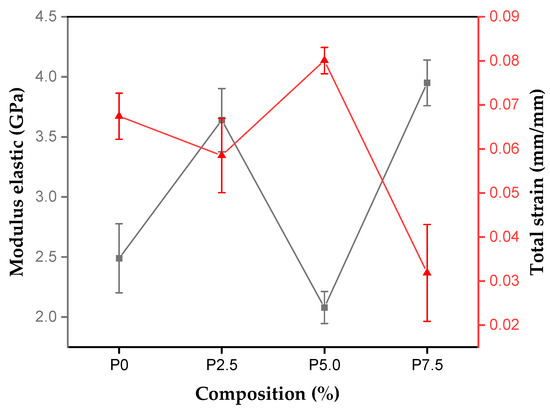
Figure 10.
Modulus of elasticity and strain results for composites with tururi fabric.
The composites produced with 7.5% reinforcement had a higher modulus of elasticity, with an average of 3.95 GPa. The increase in modulus of elasticity is associated with the uniformity and homogeneity of the microfibrils of the tururi fabric, helping to distribute the loads throughout the matrix [80].
It should be noted that as the percentage of reinforcement increases, there is also an increase in the deformation of the material, resulting in an increase in flexural strength and modulus of elasticity. This behavior can be explained by the increase in the percentage of fabric and the increase in interfaces, which reduces the deformation capacity. The random arrangement of the yarns in the fabric reduces delaminations and increases the flexural strength of the material [81,82]. NG et al. [29] explain that, during bending tests, the top layer of the fabric tends to support compression loads, while the lower layers support the tension offered. In this way, the fabrics in the outer layers tend to support more bending loads than the other layers of the material.
The morphology of the flexural fractures for the composites reinforced with 2.5% and 5.0% tururi fabric is shown in Figure 11a and Figure 11b, respectively.
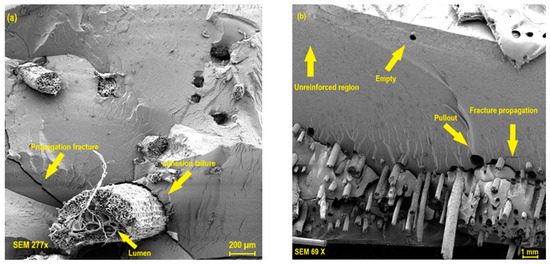
Figure 11.
Scanning electron microscopy obtained for the composites in percentages of 2.5 (a) and 7.5% (b) in mass fraction of tururi fabric.
It is possible to observe the presence of river marks which indicate that the fracture is of the brittle type for the composites with 2.5 and 5.0% fabric percentage. In addition, regions characteristic of the pull-out effect can be seen, as well as voids and pores, indicating that there was low adhesion between the fabric and the polymer matrix. This interaction results in a reduction in the flexural strength of the 2.5% and 5.0% compositions. Simonassi et al. [83] explains that the pull-out effect and the presence of voids are attributed to interfacial phenomena between the fiber and the polymer matrix, which tend to reduce the mechanical properties of composite materials [81]. Other characteristics associated with the hydrophobic characteristics between the matrix and the reinforcement can promote low interaction between the phases, causing flaws and defects along the length of the material [84]. In addition, when subjected to static loads or dynamic events, they lead to early rupture. These effects reduce the mechanical properties of composite materials reinforced with natural tururi fabric.
3.2.4. Charpy Impact Test
The results of the impact resistance test of the polymer matrix composites with different percentages of tururi fabric are shown in Figure 12.
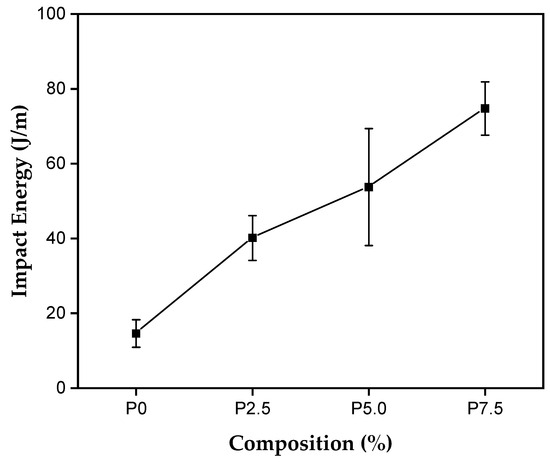
Figure 12.
Impact energy for polyester matrix and composites reinforced with tururi fabric.
Table 4 shows the Charpy impact energy results for the composites reinforced with natural tururi fabric.

Table 4.
Charpy impact results for Tururi/polyester composites.
The mean results show that the matrix and the 7.5% composition had around 14.61 J/m and 74.72 J/m, respectively. The composites produced with 7.5% showed an increase of 471.2% compared to the matrix. Therefore, the increase in impact resistance can be attributed to the increase in the percentage of reinforcement in the polymer matrix, resulting in an improvement in mechanical properties [85]. Pereira et al. [86], Pereira et al. [87] and Candido et al. [88] observed that the increase in impact energy absorption capacity is high when the percentage of reinforcement in the matrix is increased. From this, it can be said that the toughness resistance is increased by incorporating tururi fabric into the polyester matrix.
Fabrics made with natural or synthetic fibers oriented in the longitudinal and transverse directions have greater impact and load resistance due to the alignment of the fibers. In addition, fabrics, whether natural or synthetic in structure, tend to absorb more energy when compared to composites made with unidirectionally aligned fibers [89]. Chaves et al. [90] explain that since fibers are stiffer and stronger than the matrix, these properties result in stiffer and stronger composites, proportionally to the increase in the percentage of fibers.
The significant increase in impact energy is intrinsically linked to the characteristics and particularities of natural tururi fabric.
Micrographs of the fractures of composites subjected to the Charpy impact test are shown in Figure 13.
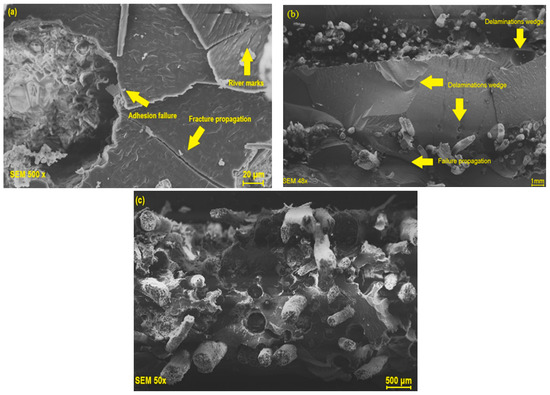
Figure 13.
Micrographs of composites reinforced with 2.5% (a), 5.0% (b) and 7.5% (c) mass fraction of tururi fabric.
Figure 13a shows marks that appear as rivers, as well as the propagation of cracks, which indicate brittle fracture. Figure 13b shows the presence of voids and propagated cracks, which result from low energy dissipation along the matrix and reinforcement. Figure 13c reveals the presence of voids or areas marked by the pull-out effect, which manifests itself when the material is subjected to the transfer of impact energy [91]. Ng et al. [29] explains that the stacking and microstructural characteristics of the fabric can lead to separations, delaminations and the pull-out effect. These factors are related to the interfacial bonding between the phases, which may be insufficient to ensure that the material absorbs even more energy, resulting in the pull-out and rupture of the material when subjected to high loads [90,92].
In addition to the failure mechanisms, the structural organization of tururi fabric facilitates better adhesion with the polymer matrix and, consequently, a better distribution of stresses throughout the material. According to Gao et al. [70] and Karthik et al. [69], fabrics comprising multilayers of synthetic or natural fibers with randomly arranged yarns favor an increase in the energy absorption and impact resistance of the composite material. Furthermore, as the relative percentage of tururi reinforcement increases, there is a reduction in apparent defects.
The use of a natural fabric reinforces the development of lightweight and sustainable composite materials with exceptional properties for various applications.
3.2.5. Statistical Analysis
Table 5 presents the analysis of variance for the mechanical characterization of composites reinforced with tururi fabric.

Table 5.
Analysis of variance for results.
The ANOVA results for flexural strength indicate that the calculated F (8.629) is higher than the critical F (3.490). For deformation, the calculated F was (17.288) and the critical F was equal to (3.490). For the modulus of elasticity, the calculated F (28.951) was higher than the critical F (3.490). The impact resistance result showed a calculated F (22.099) greater than the critical F (3.490). Based on these results, the null hypothesis of equality between the means of the properties evaluated was rejected, with a 95% confidence level. After rejecting equality on the basis of the ANOVA result, Tukey’s test was applied to identify which means differed significantly in terms of the variation in the percentage of reinforcement in the polymer matrix.
Table 6 shows the results of Tukey’s test.

Table 6.
Presents the results of the Tukey Test.
The minimum significant difference (msd) is a parameter that differentiates the averages obtained in the tests. For the properties of flexural strength, modulus of elasticity, deformation and impact resistance, the msd values were 14.810, 0.755, 0.022 and 24.280, respectively.
The results of Tukey’s test for flexural strength indicated statistical differences between the composites produced with 2.5% fabric and the other compositions. These data suggest that the composites with 2.5% fabric are less ductile but have greater strength. The differences observed in the modulus of elasticity averages confirm that adding more than 2.5% fabric significantly increases the rigidity of the material.
The Charpy impact resistance test results showed statistical differences. Composites with 5.0% and 7.5% tururi showed significant differences compared to composites with the lower percentages of 0% and 2.5%. These results indicate that increasing the percentage of fabric is associated with better impact properties.
Thus, incorporating tururi fabric into the polymer matrix tends to improve the properties of flexural strength, deformation, modulus of elasticity and impact resistance.
The characterization of tururi revealed that the fabric exhibited thermal stability up to approximately 250 °C, indicating that it can be used as a reinforcement agent for more thermally stable matrices. Furthermore, its use as a reinforcement agent in polymeric matrices showed low flexural strength values, as observed by [69,78], although these are still considered relatively high values for this property. Due to its energy absorption capacity upon impact and its visual appearance, it is suggested that the produced composite could be employed in the construction sector for the manufacturing of cladding panels and exposed bricks wall.
4. Conclusions
The characterizations of the tururi fabric and the composites revealed the following observations:
FT-IR indicated the presence of functional groups characteristic of the constituents present in tururi fabric, such as cellulose, hemicellulose and lignin. The thermogram showed the water loss from and degradation of the elemental constituents present in the fabric, as well as thermal stability at temperatures of up to 220 °C. From the XRD analysis, it was possible to identify the microfibrillar angle (7.39°) and the crystallinity index (46.67%). A morphological analysis of the tururi fabric revealed the presence of imperfections, flaws, tangles and irregular microstructural features in the fabric, as well as bifurcation regions. In the mechanical characterization by flexural test, the composites with 2.5% reinforcement showed a flexural strength and modulus of elasticity of 65 MPa and 3.76 GPa, respectively. A DMA indicated that increasing the percentage of fabric in the polymer matrix influenced the changes in vitreous temperature and the final properties of the composite material. The Charpy impact test indicated that the composition with 7.5% reinforcement showed an increase in energy absorption capacity of approximately 471% compared to the matrix. This result suggests that the energy absorption capacity increases with the incorporation of reinforcement. A fracture analysis of the composites indicated the presence of microstructural imperfections, such as porosity, voids and poor distribution of the reinforcement, attributed to the processing phase. The decrease in mechanical strength is intrinsically related to the morphological characteristics of the fabric. Compared to other studies using natural fibers as reinforcement, the new composite reinforced with fibrous fabric in a polyester polymer matrix shows great potential for applications subject to dynamic loads. Moreover, due to its good mechanical properties, tururi is an attractive alternative for use in composite materials because it is a completely natural fabric derived from a renewable natural resource.
Author Contributions
Investigation, methodology, resource, conceptualization, A.G.A.S.; investigation, conceptualization, methodology, D.d.C.B.N. and N.T.S.; visualization, methodology, F.P.D.L. and A.C.R.d.S.; Formal analysis, validation, and funding acquisition S.N.M.; visualization, curation, conceptualization, investigation, writing—review and editing, and validation, V.S.C. All authors have read and agreed to the published version of the manuscript.
Funding
The Amazon Foundation for Studies and Research (Fapespa), call for proposals Nº. 15/2021, Brazil, and Dean of Research and Graduate Studies (Propesp), Federal University of Para, financed this research.
Institutional Review Board Statement
Not applicable.
Data Availability Statement
The original contributions presented in this study are included in the article. Further inquiries can be directed to the corresponding author.
Acknowledgments
Amazon Foundation for Studies and Research (Fapespa), Coordination for the Improvement of Higher Education Personnel (Capes), Dean of Research and Graduate Studies (Propesp), Materials Science and Engineering Program (PPGCEM), Federal University of Para.
Conflicts of Interest
The authors declare no conflicts of interest.
References
- Balla, V.K.; Kate, K.H.; Satyavolu, J. Additive Manufacturing of Natural Fiber Reinforced Polymer Composites: Processing and Prospects. Compos. Part B 2019, 174, 106956. [Google Scholar] [CrossRef]
- Hossain, M.D.S.; Mobarak, M.B.; Rony, F.K.; Sultana, S.; Mahmud, M.; Ahmed, S. Fabrication and Characterization of Banana Fiber Reinforced Unsaturated Polyester Resin Based Composites. Nano Hybrids Compos. 2020, 29, 84–92. [Google Scholar] [CrossRef]
- Mekonnen, B.Y.; Mano, Y.J. Tensile and Flexural Analysis of a Hybrid Bamboo/Jute Fiber-Reinforced Composite with Polyester Matrix as a Sustainable Green Material for Wind Turbine Blades. Int. J. Eng. 2020, 33, 314–319. [Google Scholar] [CrossRef]
- Ilyas, R.A.; Khalina, A.; Nurazzi, N.M.; Lee, S.H.; Lee, C.H. Uma Revisão Abrangente em Tecido Sustentável Avançado Compósitos de polímeros de fibra natural. Polímeros 2021, 13, 471. [Google Scholar] [CrossRef]
- Cavalcanti, D.K.K.; Banea, M.D.; Neto, J.S.S. Comparative Analysis of the Mechanical and Thermal Properties of Polyester and Epoxy Natural Fiber-Reinforced Hybrid Composites. J. Compos. Mater. 2021, 55, 1683–1692. [Google Scholar] [CrossRef]
- Dipen, K.R.; Durgesh, D.P.; Ravinder, K. Recent Progress of Reinforcement Materials: A Comprehensive Overview of Composite Materials. J. Mater. Res. Technol. 2019, 8, 6354–6374. [Google Scholar] [CrossRef]
- Das Subrata, C.; Debasree, P.; Sotirios, A.I.; Siddiquee, M.A.B.; Papatzani, S.; Koralli, P.; Islam, J.M.M.; Khan, M.A.; Shauddin, S.M.; Khan, R.A.; et al. Effect of Stacking Sequence on the Performance of Hybrid Natural/Synthetic Fiber Reinforced Polymer Composite Laminates. Compos. Struct. 2021, 276, 114525. [Google Scholar] [CrossRef]
- Mindermann, P.; Gil Pérez, M.; Knippers, J.; Gresser, G.T. Investigation of the Fabrication Suitability, Structural Performance, and Sustainability of Natural Fibers in Coreless Filament Winding. Materials 2022, 15, 3260. [Google Scholar] [CrossRef]
- Kumar, S.; Prasad, L.; Bijlwan, P.P.; Yadav, A. Thermogravimetric Analysis of Lignocellulosic Leaf-Based Fiber-Reinforced Thermosets Polymer Composites: An Overview. Biomass Convers. Biorefinery 2024, 14, 12673–12698. [Google Scholar] [CrossRef]
- Zhao, X.; Li, K.; Wang, Y.; Tekinalp, H.; Richard, A.; Webb, E.; Ozcan, S. Bio-Treatment of Poplar via Amino Acid for Interface Control in Biocomposites. Compos. Part B Eng. 2020, 199, 108276. [Google Scholar] [CrossRef]
- Zhao, X.; Copenhaver, K.; Wang, L.; Korey, M.; Gardner, D.J.; Li, K.; Lamm, M.E.; Kishore, V.; Bhagia, S.; Tajvidi, M.; et al. Recycling of Natural Fiber Composites: Challenges and Opportunities. Resour. Conserv. Recycl. 2022, 177, 105962. [Google Scholar] [CrossRef]
- Asrofi, M.; Sapuan, S.M.; Ilyas, R.A.; Ramesh, M. Characteristic of Composite Bioplastics from Tapioca Starch and Sugarcane Bagasse Fiber: Effect of Time Duration of Ultrasonication (Bath-Type). Mater. Today Proc. 2020, 46, 1626–1630. [Google Scholar] [CrossRef]
- Sabaruddin, F.A.; Paridah, M.T.; Sapuan, S.M.; Ilyas, R.A.; Lee, S.H.; Abdan, K.; Mazlan, N.; Roseley, A.S.M.; Abdul Khalil, H.P.S. The Effects of Unbleached and Bleached Nanocellulose on the Thermal and Flammability of Polypropylene-Reinforced Kenaf Core Hybrid Polymer Bionanocomposites. Polymers 2020, 13, 116. [Google Scholar] [CrossRef]
- Gohal, H.; Kumar, V.; Jena, H. Study of Natural Fiber Composite Material and Its Hybridization Techniques. Mater. Today Proc. 2020, 26, 1368–1372. [Google Scholar] [CrossRef]
- Haris, N.I.N.; Hassan, M.Z.; Ilyas, R.A.; Suhot, M.A.; Sapuan, S.M.; Dolah, R.; Mohammad, R.L.; Asyraf, M.R.M. Dynamic Mechanical Properties of Natural Fiber Reinforced Hybrid Polymer Composites: A Review. J. Mater. Res. Technol. 2022, 19, 167–182. [Google Scholar] [CrossRef]
- Karimah, A.; Ridho, M.R.; Munawar, S.S.; Adi, D.S.; Damayanti, R.; Subiyanto, B.; Fatriasari, W.; Fudholi, A. A review on natural fibers for development of eco-friendly bio-composite: Characteristics, and utilizations. J. Mater. Res. Technol. 2021, 13, 2442–2458. [Google Scholar] [CrossRef]
- Alhijazi, M.; Safaei, B.; Zeeshan, Q.; Asmael, M.; Eyvazian, A.; Qin, Z. Recent Developments in Luffa Natural Fiber Composites: Review. Sustainability 2020, 12, 7683. [Google Scholar] [CrossRef]
- Ribeiro, M.M.; Pinheiro, M.A.; Rodrigues, J.d.S.; Ramos, R.P.B.; Corrêa, A.d.C.; Monteiro, S.N.; da Silva, A.C.R.; Candido, V.S. Comparison of Young’s Modulus of Continuous and Aligned Lignocellulosic Jute and Mallow Fibers Reinforced Polyester Composites Determined Both Experimentally and from Theoretical Prediction Models. Polymers 2022, 14, 401. [Google Scholar] [CrossRef]
- Kumar, S.S. Effect of Natural Fiber Loading on Mechanical Properties and Thermal Characteristics of Hybrid Polyester Composites for Industrial and Construction Fields. Fibers Polym. 2020, 21, 1508–1514. [Google Scholar] [CrossRef]
- Sarikaya, E.; Çallioğlu, H.; Demirel, H. Production of Epoxy Composites Reinforced by Different Natural Fibers and Their Mechanical Properties. Compos. Part B Eng. 2019, 167, 461–466. [Google Scholar] [CrossRef]
- Bachchan, A.A.; Das, P.P.; Chaudhary, V. Effect of Moisture Absorption on the Properties of Natural Fiber Reinforced Polymer Composites: A Review. Mater. Today Proc. 2021, 49, 3403–3408. [Google Scholar] [CrossRef]
- Gazem de Carvalho, J.P.R.; Duarte Lopes, F.P.; Simonassi, N.T.; Neves, A.C.C.; Atem de Carvalho, E.; Monteiro, S.N.; Vieira, C.M.F. Methodological Analysis of Composites Green Polyurethane Resin Reinforced with Jute Fabric. Case Stud. Constr. Mater. 2022, 17, e01512. [Google Scholar] [CrossRef]
- Mishra, T.; Mandal, P.; Rout, A.K.; Sahoo, D. A State-of-the-Art Review on Potential Applications of Natural Fiber-Reinforced Polymer Composite Filled with Inorganic Nanoparticle. Compos. Part C Open Access 2022, 9, 100298. [Google Scholar] [CrossRef]
- Akhil, U.V.; Radhika, N.; Saleh, B.; Krishna, S.A.; Nobre, N.; Rajeshkumar, L. Uma Revisão Abrangente Sobre Compósitos Poliméricos Reforçados A comprehensive review on plant-based natural fiber reinforced polymer composites: Fabrication, properties, and applications. Polím. Compós. 2023, 44, 2598–2633. [Google Scholar] [CrossRef]
- Liu, S.; Dong, C.; Yuan, C.; Bai, X.; Tian, Y.; Zhang, G. A new polyimide matrix composite to improve friction-induced chatter performance through reducing fluctuation in friction force. Compos. Part B Eng. 2021, 217, 108887. [Google Scholar] [CrossRef]
- Monteiro, A.S.; Dantas, D.; Yojo, T. Preparation of Amazonian Palm Tree Fiber (Manicaria saccifera Gaertn.) for Composite Materials. U.Porto J. Eng. 2021, 7, 31–36. [Google Scholar] [CrossRef]
- Oliveira, J.R.; Kotzebue, L.R.V.; Freitas, D.B.; Mattos, A.L.A.; da Costa Júnior, A.E.; Mazzetto, S.E.; Lomonaco, D. Towards Novel High-Performance Bio-Composites: Polybenzoxazine-Based Matrix Reinforced with Manicaria saccifera Fabrics. Compos. Part B Eng. 2020, 194, 108060. [Google Scholar] [CrossRef]
- Ng, L.F.; Yahya, M.Y.; Muthukumar, C. Mechanical Characterization and Water Absorption Behaviors of Pineapple Leaf/Glass Fiber-Reinforced Polypropylene Hybrid Composites. Polym. Compos. 2022, 43, 203–214. [Google Scholar] [CrossRef]
- Ng, L.F.; Yahya, M.Y.; Muthukumar, C.; Parameswaranpillai, J.; Ma, Q.; Muhammad Asyraf, M.R.; Abdul Majid, R. Mechanical Characterization, Water Absorption, and Thickness Swelling of Lightweight Pineapple Leaf/Ramie Fabric-Reinforced Polypropylene Hybrid Composites. Polymers 2024, 16, 1847. [Google Scholar] [CrossRef]
- Monteiro, A.S.; Leonardi, B.; Savastano, H., Jr.; Baruque-Ramos, J. Tururi Palm Fibrous Material (Manicaria saccifera Gaertn.) Characterization. Green Mater. 2015, 3, 120–131. [Google Scholar] [CrossRef]
- Porras, A.; Maranon, A.; Ashcroft, I.A. Characterization of a Novel Natural Cellulose Fabric from Manicaria saccifera Palm as Possible Reinforcement of Composite Materials. Compos. Part B Eng. 2015, 74, 66–73. [Google Scholar] [CrossRef]
- Midani, M.; Seyam, A.F.M.; Monteiro, A.S.; Baruque-Ramos, J. Effect of Structural Parameters on the Impact Properties of Multilayer Composites from Tururi Palm (Manicaria saccifera Gaertn.) Fibrous Material. J. Nat. Fibers 2018, 17, 284–297. [Google Scholar] [CrossRef]
- Botanical Garden Lancetilla. Manicaria Saccifera Gaertn. 2014. Available online: http://jblancetilla.org/manicaria_saccifera_gaertn.htm (accessed on 27 October 2024).
- ASTM D790-17; Standard Test Method for Flexural Properties of Unreinforced and Reinforced Plastics and Electrical Insulating Materials. American Society for Testing and Materials (ASTM): West Conshohocken, PA, USA, 2017.
- ASTM D6110-18; Standard Test Method for Determining the Charpy Impact Resistance of Notched Specimens of Plastics. American Society for Testing and Materials (ASTM): West Conshohocken, PA, USA, 2010.
- Segal, L.A.; Creely, J.J.; Martin, A.E.; Conrad, C.M. An Empirical Method for Estimating the Degree of Crystallinity of Native Cellulose Using the X-ray Diffractometer. Text. Res. J. 1959, 29, 786–794. [Google Scholar] [CrossRef]
- Cave, I.D. X-ray Microfibril Angle Measurement. For. Prod. J. 1966, 16, 37–42. [Google Scholar]
- Pinheiro, M.A.; Gomes, L.G.; da Silva, A.C.R.; Candido, V.S.; Reis, R.H.M.; Monteiro, S.N. Guaruman: A Natural Amazonian Fiber with Potential for Polymer Composite Reinforcement. Mater. Res. 2019, 22, e20190092. [Google Scholar] [CrossRef]
- Reis, R.H.M.; Nunes, L.F.; Oliveira, M.S.; Veiga Júnior, V.F.; Garcia Filho, F.C.; Pinheiro, M.A.; Cândido, V.S.; Monteiro, S.N. Fibra Guaruman: Another possible reinforcement in composites. J. Mater. Res. Technol. 2020, 9, 6. [Google Scholar] [CrossRef]
- Marchi, B.Z.; Oliveira, M.S.; Bezerra, W.B.A.; de Sousa, T.G.; Candido, V.S.; da Silva, A.C.R.; Monteiro, S.N. Ubim Fiber (Geonoma baculífera): A Less Known Brazilian Amazon Natural Fiber for Engineering Applications. Sustainability 2022, 14, 421. [Google Scholar] [CrossRef]
- Pinheiro, M.A.; Ribeiro, M.M.; Rosa, D.L.S.; Nascimento, D.d.C.B.; da Silva, A.C.R.; dos Reis, M.A.L.; Monteiro, S.N.; Candido, V.S. Periquiteira (Cochlospermum orinocense): A Promising Amazon Fiber for Application in Composite Materials. Polymers 2023, 15, 2120. [Google Scholar] [CrossRef] [PubMed]
- Junio, R.F.P.; de Mendonça Neuba, L.; Souza, A.T.; Pereira, A.C.; Nascimento, L.F.C.; Monteiro, S.N. Thermochemical and Structural Characterization of Promising Carnauba Novel Leaf Fiber (Copernicia prunifera). J. Mater. Res. Technol. 2022, 18, 4714–4723. [Google Scholar] [CrossRef]
- Stevulova, N.; Cigasova, J.; Estokova, A.; Terpakova, E.; Geffert, A.; Kacik, F.; Singovszka, E.; Holub, M. Properties Characterization of Chemically Modified Hemp Hurds. Materials 2014, 7, 8131–8150. [Google Scholar] [CrossRef] [PubMed]
- Viscusi, G.; Barra, G.; Gorrasi, G. Modification of Hemp Fibers Through Alkaline Attack Assisted by Mechanical Milling: Effect of Processing Time on the Morphology of the System. Cellulose 2020, 27, 8653–8665. [Google Scholar] [CrossRef]
- da Silveira, P.H.P.M.; Santos, M.C.C.d.; Chaves, Y.S.; Ribeiro, M.P.; Marchi, B.Z.; Monteiro, S.N.; Gomes, A.V.; Tapanes, N.d.L.C.O.; Pereira, P.S.d.C.; Bastos, D.C. Characterization of Thermo-Mechanical and Chemical Properties of Polypropylene/Hemp Fiber Biocomposites: Impact of Maleic Anhydride Compatibilizer and Fiber Content. Polymers 2023, 15, 3271. [Google Scholar] [CrossRef]
- Hossain, S.; Jalil, M.A.; Islam, T.; Rahman, M.M. A Low-Density Cellulose Rich New Natural Fiber Extracted from the Bark of Jack Tree Branches and Its Characterizations. Heliyon 2022, 8, e11667. [Google Scholar] [CrossRef] [PubMed]
- Costa, U.O.; Nascimento, L.F.C.; Garcia, J.M.; Bezerra, W.B.A.; da Luz, F.S.; Pinheiro, W.A.; Monteiro, S.N. Mechanical Properties of Composites with Graphene Oxide Functionalization of Either Epoxy Matrix or Curaua Fiber Reinforcement. J. Mater. Res. Technol. 2020, 9, 13390–13401. [Google Scholar] [CrossRef]
- Rekha, B.; NagarajaGanesh, B. X-ray Diffraction: An Efficient Method to Determine Microfibrillar Angle of Dry and Matured Cellulosic Fibers. J. Nat. Fibers 2022, 19, 3689–3696. [Google Scholar] [CrossRef]
- Demóstenes, L.C.C.; Nascimento, L.F.C.; Monteiro, S.N.; Costa, U.O.; da Costa Garcia Filho, F.; da Luz, F.S.; Oliveira, M.S.; Ramos, F.J.H.T.V.; Pereira, A.C.; Braga, F.O. Thermal and Structural Characterization of Buriti Fibers and Their Relevance in Fabric-Reinforced Composites. J. Mater. Res. Technol. 2020, 9, 115–120. [Google Scholar] [CrossRef]
- Subramanian, S.G.; Rajkumar, R.; Ramkumar, T. Characterization of Natural Cellulosic Fiber from Cereus hildmannianus. J. Nat. Fibers 2021, 18, 343–354. [Google Scholar] [CrossRef]
- Ding, L.; Han, X.; Li, H.; Han, J.; Cao, L.; Chen, Y.; Ling, Z.; He, S.; Jiang, S. Characterization of Novel Natural Fiber from Manau Rattan (Calamus manan) as a Potential Reinforcement for Polymer-Based Composites. J. Bioresour. Bioprod. 2022, 7(3), 190–200. [Google Scholar] [CrossRef]
- Khan, A.; Vijay, R.; Singaravelu, D.L.; Sanjay, M.R.; Siengchin, S.; Jawaid, M.; Asiri, A.M. Extraction and Characterization of Natural Fibers from Citrullus lanatus Climber. J. Nat. Fibers 2020, 19, 621–629. [Google Scholar] [CrossRef]
- Selvan, M.T.G.A.; Binoj, J.S.; Moses, J.T.E.J.; Sai, N.P.; Siengchin, S.; Sanjay, M.R.; Liu, Y. Extraction and Characterization of Natural Cellulosic Fiber from Fragrant Screw Pine Prop Roots as Potential Reinforcement for Polymer Composites. Polym. Compos. 2022, 43, 320–329. [Google Scholar] [CrossRef]
- Manimaran, P.; Senthamaraikannan, P.; Sanjay, M.R.; Marichelvam, M.K.; Jawaid, M. Study on Characterization of Furcraea foetida New Natural Fiber as Composite Reinforcement for Lightweight Applications. Carbohydr. Polym. 2018, 181, 650–658. [Google Scholar] [CrossRef] [PubMed]
- Dalmis, R.; Kilic, G.B.; Seki, Y.; Koktas, S.; Keskin, O.Y. Characterization of a Novel Natural Cellulosic Fiber Extracted from the Stem of Chrysanthemum morifolium. Cellulose 2020, 27, 8621–8634. [Google Scholar] [CrossRef]
- Khan, A.; Vijay, R.; Singaravelu, D.L.; Sanjay, M.R.; Siengchin, S.; Verpoort, F.; Alamry, K.A.; Asiri, A.M. Characterization of Natural Fibers from Cortaderia selloana Grass (Pampas) as Reinforcement Material for the Production of Composites. J. Nat. Fibers 2021, 18, 1893–1901. [Google Scholar] [CrossRef]
- Mannai, F.; Elhleli, H.; Dufresne, A.; Elaloui, E.; Moussaoui, Y. Opuntia (Cactaceae) Fibrous Network-Reinforced Composites: Thermal, Viscoelastic, Interfacial Adhesion, and Biodegradation Behavior. Fibers Polym. 2020, 21, 2353–2363. [Google Scholar] [CrossRef]
- Lai, T.S.M.; Jayamani, E.; Soon, K.H. Comparative Study on Thermogravimetric Analysis of Banana Fibers Treated with Chemicals. Mater. Today Proc. 2023, 78, 458–461. [Google Scholar] [CrossRef]
- Heckadka, S.S.; Ballambat, R.P.; Bhagavath, P.; Kini, M.V.; Sinha, R.K.; Sonali, M.K.; Sen, D. Thermogravimetric Analysis of Flax, Jute, and UHMWPE Fibers and Their Composites with Melamine and Phenol Formaldehyde Resins. Cogent Eng. 2023, 10, 2209990. [Google Scholar] [CrossRef]
- Jaruwan, M.; Klinkosum, P.; Chaichanasongkram, T.; Sarak, S.; Kaewtatip, K. Caracterização de uma nova fibra de celulose natural de Enhalus acoroides e sua potencial aplicação. Ind. Crops Prod. 2022, 186, 115285. [Google Scholar] [CrossRef]
- Asim, M.; Paridah, M.T.; Chandrasekar, M.; Shahroze, R.M.; Jawaid, M.; Nasir, M.; Siakeng, R. Thermal Stability of Natural Fibers and Their Polymer Composites. Iran. Polym. J. 2020, 29, 625–648. [Google Scholar] [CrossRef]
- Raja, A.K.A.; Geethan, K.A.V.; Kumar, S.S.; Kumar, P.S. Influência de atributos mecânicos, absorção de água, características de deflexão de calor e caracterização de compósitos híbridos epóxi reforçados com fibras naturais para uma aplicação de engenharia. Fibers Polym. 2021, 22, 3444–3455. [Google Scholar] [CrossRef]
- Sathishkumar, T.P.; Shah, M.A.; Panchal, H.; Sharma, K.; Gopinath, R.; Sanjay, M.R.; Siengchin, S.; Rajesh Kumar, L.; Rampradheep, G.S. Characterization of New Cellulose Fiber Extracted from Second Generation Bitter Albizia Tree. Sci. Rep. 2024, 14, 1693. [Google Scholar] [CrossRef]
- Madhu, P.; Sanjay, M.R.; Senthamaraikannan, P.; Pradeep, S.; Siengchin, S.; Jawaid, M.; Kathiresan, M. Effect of Various Chemical Treatments of Prosopis juliflora Fibers as Composite Reinforcement: Physicochemical, Thermal, Mechanical, and Morphological Properties. J. Nat. Fibers 2020, 17, 833–844. [Google Scholar] [CrossRef]
- Maheshwaran, M.V.; Hyness, N.R.J.; Senthamaraikannan, P.; Saravanakumar, S.S.; Sanjay, M.R. Characterization of Natural Cellulosic Fiber from Epipremnum aureum Stem. J. Nat. Fibers 2017, 15, 789–798. [Google Scholar] [CrossRef]
- Tamanna, T.A.; Belal, S.A.; Shibly, M.A.H.; Khan, A.N. Characterization of a New Natural Fiber Extracted from Corypha taliera Fruit. Sci. Rep. 2021, 11, 7622. [Google Scholar] [CrossRef]
- Rajeshkumar, G.; Arvindh Seshadri, S.; Devnani, G.L.; Sanjay, M.R.; Siengchin, S.; Prakash Maran, J.; Al-Dhabi, N.A.; Karuppiah, P.; Mariadhas, V.A.; Sivarajasekar, N.; et al. Environment friendly, renewable and sustainable poly lactic acid (PLA) based natural fiber reinforced composites—A comprehensive review. J. Clean. Prod. 2021, 310, 127483. [Google Scholar] [CrossRef]
- Oliveira, A.K.F.; d’Almeida, J.R.M. Characterization of Ubuçu (Manicaria saccifera) Natural Fiber Mat. Polym. Renew. Resour. 2014, 5, 13–28. [Google Scholar] [CrossRef]
- Karthik, A.; James, D.J.; Vijayan, V.; Ahmad, Z.; Rajkumar, S.; Sharma, S.; Sharma, K.P.; Singh, R.; Li, C.; Eldin, S.M. Study on the Physicomechanical, Fracture-Strain, Interface-Adhesion, and Water-Absorption Properties of Twill Fabric Cotton-Bamboo/Epoxy Composites. J. Mater. Res. Technol. 2023, 24, 8429–8442. [Google Scholar] [CrossRef]
- Gao, I.; Fezzaa, K.; Chen, W. Multiscale dynamic experiments on fiber-reinforced composites with damage assessment using high-speed synchrotron X-ray phase-contrast imaging. NDT E Int. 2022, 129, 102636. [Google Scholar] [CrossRef]
- Vijay, R.; James Dhilip, J.D.; Gowtham, S.; Harikrishnan, S.; Chandru, B.; Amarnath, M.; Khan, A. Characterization of Natural Cellulose Fiber from the Barks of Vachellia farnesiana. J. Nat. Fibers 2020, 19, 1343–1352. [Google Scholar] [CrossRef]
- Alves Fidelis, M.E.; Pereira, T.V.C.; Gomes, O.D.F.M.; De Andrade, S.F.; Toledo Filho, R.D. The effect of fiber morphology on the tensile strength of natural fibers. J. Mater. Res. Technol. 2013, 2, 149–157. [Google Scholar] [CrossRef]
- Akter, N.; Das, S.C.; Fahad, M.M.; Islam, D.; Khan, M.A.; Shamsuddin, S.M. Tailoring the performance of cellulosic textiles by chemical treatment and ionizing radiation: Assessment of physical, mechanical, thermal, crystal and morphological properties. Next Mater. 2025, 7, 100372. [Google Scholar] [CrossRef]
- Triki, A.; Dittmer, J.; Hassen, M.B.; Arous, M.; Bulou, A.; Gargouri, M. Spectroscopy analyses of hybrid unsaturated polyester composite reinforced by Alfa, wool, and thermo-binder fibers. Polym. Sci. Ser. A 2016, 58, 255–264. [Google Scholar] [CrossRef]
- Ali, M.F.; Hossain, M.S.; Moin, T.S.; Ahmed, S.; Chowdhury, A.M.S. Utilization of waste chicken feather for the preparation of eco-friendly and sustainable composite. Clean. Eng. Technol. 2021, 4, 100190. [Google Scholar] [CrossRef]
- Alshahrani, H.; Arun Prakash, V.R. Mechanical, thermal, viscoelastic, and hydrophobicity behavior of complex grape stalk lignin and bamboo fiber reinforced polyester composite. Int. J. Biol. Macromol. 2022, 223, 851–859. [Google Scholar] [CrossRef]
- Prasad, L.; Singh, V.; Patel, R.V.; Yadav, A.; Kumar, V.; Winczek, J. Physical and Mechanical Properties of Rambans (Agave) Fiber Reinforced with Polyester. J. Nat. Fibers 2021, 19, 6104–6118. [Google Scholar] [CrossRef]
- Dhibar, B.; Singh, S.V.; Anwar, S.; Singh, A. Sugarcane Bagasse Reinforced Polyester Composites. Int. Res. J. Eng. Technol. (IRJET) 2018, 5, 4204–4211. [Google Scholar] [CrossRef]
- Ganesan, K.; Kailasanathan, C.; Rajini, N.; Ismail, S.O.; Ayrilmis, N.; Mohammad, F.; Al-Lohedan, H.A.; Tawfeek, A.M.; Issa, Z.A.; Aldhayan, D.M. Assessment on hybrid jute/coir fibers reinforced polyester composite with hybrid fillers under different environmental conditions. Constr. Build. Mater. 2021, 301, 124117. [Google Scholar] [CrossRef]
- Patel, U.; Ray, R.; Mohapatra, A.; Das, S.N.; Das, H.C. Effect of Different Chemical Treatments on Surface Morphology, Thermal, and Traction Strength of Bauhinia Vahlii (BV) Stem Fibers. J. Nat. Fibers 2020, 19, 280–291. [Google Scholar] [CrossRef]
- Neto, J.; Queiroz, H.; Aguiar, R.; Lima, R.; Cavalcanti, D.; Banea, M.D. A Review of Recent Advances in Hybrid Natural Fiber Reinforced Polymer Composites. J. Renew. Mater. 2022, 10, 561. [Google Scholar] [CrossRef]
- Meliande, N.M.; Silveira, P.H.P.M.d.; Monteiro, S.N.; Nascimento, L.F.C. Tensile Properties of Curaua–Aramid Hybrid Laminated Composites for Ballistic Helmet. Polymers 2022, 14, 2588. [Google Scholar] [CrossRef]
- Simonassi, N.T.; Pereira, A.C.; Monteiro, S.N.; Margem, F.M.; Rodríguez, R.J.S.; Deus, J.F.D.; Vieira, C.M.F.; Drelich, J. Reinforcement of Polyester with Renewable Ramie Fibers. Mater. Res. 2017, 20 (Suppl. S2), 51–59. [Google Scholar] [CrossRef]
- Vignesh, V.; Balaji, A.N.; Nagaprasad, N.; Sanjay, M.R.; Khan, A.; Asiri, A.M.; Ashraf, G.M.; Siengchin, S. Indian mallow fiber reinforced polyester composites: Mechanical and thermal properties. J. Mater. Res. Technol. 2021, 11, 274–284. [Google Scholar] [CrossRef]
- Hossain, M.T.; Hossain, M.S.; Uddin, M.B.; Khan, R.A.; Chowdhury, A.S. Preparation and characterization of sodium silicate–treated jute-cotton blended polymer–reinforced UPR-based composite: Effect of γ-radiation. Adv. Compos. Hybrid Mater. 2021, 4, 257–264. [Google Scholar] [CrossRef]
- Pereira, A.C.; Monteiro, S.N.; Assis, F.S. Charpy Toughness Behavior of Fique Fabric Reinforced Polyester Matrix Composites. In Characterization of Minerals, Metals, and Materials 2017; Ikhmayies, S., Li, B., Carpenter, J.S., Li, J., Hwang, J.-Y., Monteiro, S.N., Firrao, D., Zhang, M., Peng, Z., Escobedo-Diaz, J.P., et al., Eds.; The Minerals, Metals & Materials Series; Springer: Cham, Switzerland, 2017. [Google Scholar] [CrossRef]
- Pereira, A.C.; Assis, F.S.; Filho, F.C.G. Evaluation of the Projectile’s Loss of Energy in Polyester Composite Reinforced with Fique Fiber and Fabric. Mater. Res. 2019, 22 (Suppl. S1), e20190146. [Google Scholar] [CrossRef]
- Candido, V.S.; Silva, A.C.R.; Simonassi, N.T.; da Luz, F.S.; Monteiro, S.N. Toughness of Polyester Matrix Composites Reinforced with Sugarcane Bagasse Fibers by Charpy Impact Tests. J. Mater. Res. Technol. 2017, 6, 334–338. [Google Scholar] [CrossRef]
- Kayaaslan, M.; Coskun, T.; Unlu, U.M.; Sahin, O.S. Effects of Thickness, Fiber Orientation and Fabric Textile on the Low-Velocity Impact Performances of Thermoset and Thermoplastic Composites. J. Thermoplast. Compos. Mater. 2023, 36, 4408–4429. [Google Scholar] [CrossRef]
- Chaves, Y.S.; Monteiro, S.N.; Nascimento, L.F.C.; Rio, T.G.-d. Mechanical and Ballistic Properties of Epoxy Composites Reinforced with Babassu Fibers (Attalea speciosa). Polymers 2024, 16, 913. [Google Scholar] [CrossRef]
- Sheng, C.; He, G.; Hu, Z.; Chou, C.; Shi, J.; Li, J.; Meng, Q.; Ning, X.; Wang, L.; Ning, F. Yarn on Yarn Abrasion Failure Mechanism of Ultrahigh Molecular Weight Polyethylene Fiber. J. Eng. Fibers Fabr. 2021, 16, 1925832385. [Google Scholar] [CrossRef]
- Vallejos, M.E.; Vilaseca, F.; Méndez, J.A.; Espinach, F.X.; Aguado, R.J.; Delgado-Aguilar, M.; Mutjé, P. Response of Polypropylene Composites Reinforced with Natural Fibers: Impact Strength and Water-Uptake Behaviors. Polymers 2023, 15, 900. [Google Scholar] [CrossRef] [PubMed]
Disclaimer/Publisher’s Note: The statements, opinions and data contained in all publications are solely those of the individual author(s) and contributor(s) and not of MDPI and/or the editor(s). MDPI and/or the editor(s) disclaim responsibility for any injury to people or property resulting from any ideas, methods, instructions or products referred to in the content. |
© 2025 by the authors. Licensee MDPI, Basel, Switzerland. This article is an open access article distributed under the terms and conditions of the Creative Commons Attribution (CC BY) license (https://creativecommons.org/licenses/by/4.0/).